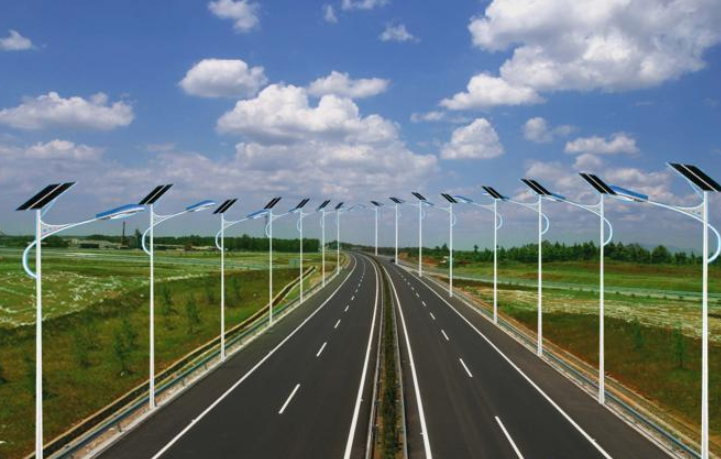How to calculate the actual power of solar street lights?
2022-05-07

Next, I will tell you how to calculate the actual power of solar street lights. The actual power of the solar street light with the DC clamp meter is always changing. We are talking about how to calculate the actual power of the solar street light. This point should be stated in advance.
The actual power of solar street lights is always changing. No matter which method we use, we can only calculate a rough actual power, which is basically equivalent to the average power of the solar street light during the high-brightness period. Therefore, this value is also very informative.
Why does the actual power of solar street lights keep changing?
1. Before leaving the factory, most solar street lights are set to 3-6 stages of power output. Take overnight work as an example. The most common setting methods are as follows:
Highlight period (2-4 hours): 1 hour 100% brightness + 2 hours 60%-70% brightness
Second-brightness period (1-2 hours): 40% brightness for 2 hours
Low brightness period (6-7 hours): 10% brightness for 6 hours
Second-brightness period (1-2 hours): 30-40% brightness for 2 hours
In this way, the full power working time of the street light is about 4.5 hours. Of course, according to the working hours required by customers, the full working hours set by the configuration of each company will be different.
2 The automatic power reduction function of the controller The controller will automatically increase or decrease the output power according to the voltage of the battery and on the basis of the set data (maximum does not exceed the set value) every time the controller discharges.
Method 1 for calculating the actual power of solar street lamps: Clamp meter measurement method
If you happen to have this set of programming remote controller matching the solar street light controller, you can directly know the actual power of the solar street light by reading the parameters, but the end user generally does not have a programmer, but the DC current clamp meter can be purchased . Why use a clamp meter, because the clamp meter is more convenient to measure the current, and the multimeter is more troublesome to measure the current. But it should be noted that it must be a clamp meter that can measure DC current, and pay attention to the current range value of the test.
The test steps are as follows:
1. Fully charge the battery
2. Disconnect the charging cable and enter the discharge mode
3. Test the line end of the controller connected to the light source
4. Test out the voltage and current
5. Calculate the actual power of the solar street light
The clamp meter measurement method is the simplest and most direct method, and it is also the most recommended method among the three methods of how to calculate the actual power of solar street lamps. If you are more patient, you can measure it every hour, and you can also measure how the solar street light power is set by the manufacturer.
The second method of calculating the actual power of solar street lamps: solar panel power inversion method
The actual power of the solar panel reverse push solar street light is based on: the daily power generation of the solar panel = the daily power consumption of the light source.
Daily power generation of solar panels = solar panel power x peak sunshine hours/2.22
The daily power consumption of the light source = the actual power of the solar street light x the working time of full power
[Note] 2.22 is the coefficient calculated by the coulomb efficiency of the battery and the charging efficiency of the solar panel. The system of this system with different voltages is also different. It is not so complicated here, and the conversion efficiency of the controller is not calculated.
The calculation formula is: the actual power of the light source = the power of the solar panel x the peak sunshine hours/the working time of the full power of the light source/2.22
For example: Find the parameters of a hot-selling solar street light on a certain platform and calculate: How many watts is the actual power of a 3000W project solar street light?
It can be seen that the configuration of this 3000W engineering solar street light is as follows: light source 3000W, solar panel 6V 30W, battery 3.2V 70000mah. For domestic use, we take 3H for the peak sunshine hours, it is illuminated all night, and the full power working time takes 4.5H. His lithium battery ratio is not reasonable, so it is not a lithium battery.
Let's take a look at how the actual power of solar street lights is calculated: light source power=30x3/4.5/2.22=9W
The actual power of the 3000W engineering solar street light is only 9W! ! A little exaggeration! !
The second method of calculating the actual power of solar street lamps: battery capacity inversion method
The premise of this method is that the depth of discharge of the lithium battery is controlled at 50%, that is, the battery is used up in 2 days, which means 2 absolutely cloudy and rainy days. The solar street lights on the market may use up all the battery power on the same day. We do not recommend this. Continuous deep cycle every day has a great impact on the battery life. It also took 3 days to run out of battery. However, due to cost reasons, most of them are used up in 2 days, and the number of days can be changed accordingly.
Therefore, battery power (WH) = actual power of solar street lights x full power working time x 2 / depth of discharge (90% for lithium batteries)
Battery capacity (AH)=WH/V
So: the actual power of the light source = battery capacity x battery voltage / 2.22 / light source full power working time
This 105W solar street light, the solar panel power is not written, only the battery capacity is 6.4V 10000mah, which is 6.4V 10AH.
Light source power=20x6.4/2.22/4.5=12.8W
The parameter table writes that the total luminous flux of the light source is 1080lm, divided by the power to obtain a light effect of 84.4lm/W. Small golden bean-shaped lamps with glass, the light efficiency of 84.4lm/W is in line with conventional cognition.




